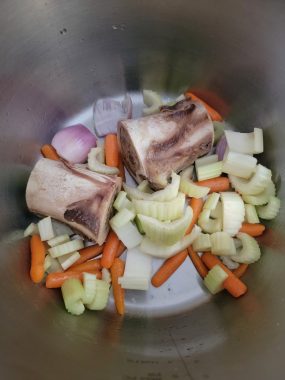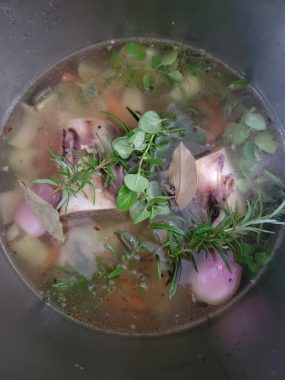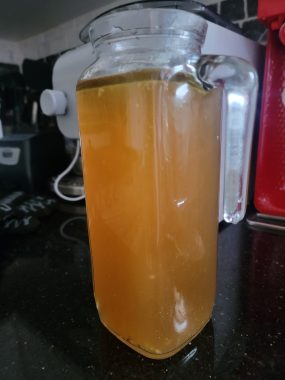The Health Benefits of Bone Broth, and How to Cook It
The simple liquid can potentially ease inflammation in those with NMO
Written by |

If you’ve been around the medical community long enough, you’ve likely heard the term “gut health.” But what exactly does that mean, and how does one create an optimal internal balance?
Good gut health, generally speaking, is having the right balance of good bacteria and other microbes in the digestive tract. As for how one creates that balance, I’ve been on a journey to figure this out. As a patient with neuromyelitis optica (NMO), I’ll try just about anything to improve my condition.
Other patients advocate for lifestyle changes, like their diets, so it’s high time I make a more concerted effort.
Bone broth
Many patients have suggested drinking bone broth, which is believed to be beneficial to our joints, digestive system, and skin because it contains many important minerals and nutrients. I find the idea of drinking a cup of broth repulsive. I can’t imagine enjoying my morning cup of tea, followed by a cup of broth. However, I’m willing to incorporate bone broth into my cooking.
I’ve seen bone broth available for sale in high-end grocers, but I’m ambitious, so I decided to make a batch myself. There’s also a powdered additive version, but I’m not sure I trust anything with ingredients I can’t say correctly.
What is bone broth, though?
It’s a liquid that’s obtained from simmering meaty joints and bones in water for a lengthy amount of time. It’s different from stock, which you can make in a much shorter amount of time.
The benefits of bone broth
There are various benefits of bone broth, although it depends on the quantity and types of bones you use to produce it. I decided to use a couple of beef joints in my recipe.
- Bones and their marrow are rich in vitamins and nutrients, especially if you add vegetables to the broth-making process. Bone tissue also has collagen, creating important amino acids.
- Consuming bone broth adds gelatin to your diet, which will protect the joints.
- For NMO patients who’ve had several steroid treatments, joint protection is incredibly important, especially if you now suffer from osteoarthritis.
- Bone broth helps reduce inflammation, improve sleep, and support weight loss.
The process of making bone broth
Making my own bone broth was a substantial process. First, I had to blanch the bones by simmering them in my Dutch oven pot for 15 minutes. This was followed by roasting them with my favorite vegetables to maximize their flavor.

Blanching the bones for bone broth. (Photo by Jennifer van Amerom)
I did the roasting process directly in my Instant Pot, although others have used the broil feature and put the joints in the oven. Next, I used my pressure cooker and placed the joints, vegetables, and fresh herbs from my backyard garden in water with a teaspoon of apple cider vinegar, and I cooked it all for two hours. Others use slow cookers for around 10 to 12 hours if they don’t own a pressure cooker.

Right before starting the pressure cooker to make bone broth. (Photo by Jennifer van Amerom)
There’s no rhyme or reason to knowing when the broth is done, but a quick search on the internet showed approximate times and a consensus of what to look for, which is a brown, cloudy liquid. After straining the liquid, the result looks like any other broth or stock.

Finished bone broth. (Photo by Jennifer van Amerom)
Be warned though — once the broth is refrigerated, it will cover itself with a fatty, gelatinous layer. Once you reheat it, this layer blends back into the bone broth.
Lastly, I incorporated the broth into my homemade pasta, instead of using water. It added a rich layer of flavor. My family has decided that this addition is a level up to our pasta making.

Homemade pasta: elbow noodles coming out of the pasta machine. (Photo by Jennifer van Amerom)
Does it really help?
One of the key components of bone broth is its amino acids, including glycine and arginine. These amino acids have strong anti-inflammatory properties, which might serve NMO patients. Arginine is known to be beneficial for chronic inflammation. On a good day, chronic inflammation is the best way to describe the residual outcome from my transverse myelitis and optic neuritis attacks.
While the process to produce my own bone broth took some time, it didn’t bother me, as I enjoy cooking and experimenting in my kitchen. I’m in the early days in this lifestyle change of incorporating bone broth, but after eating our usual pasta dish, I didn’t feel as bloated. That feels like I’m already making an improvement to my gut health.
Note: Neuromyelitis News is strictly a news and information website about the disease. It does not provide medical advice, diagnosis, or treatment. This content is not intended to be a substitute for professional medical advice, diagnosis, or treatment. Always seek the advice of your physician or other qualified health providers with any questions you may have regarding a medical condition. Never disregard professional medical advice or delay in seeking it because of something you have read on this website. The opinions expressed in this column are not those of Neuromyelitis News or its parent company, Bionews, and are intended to spark discussion about issues pertaining to neuromyelitis optica spectrum disorder (NMOSD).







Leave a comment
Fill in the required fields to post. Your email address will not be published.